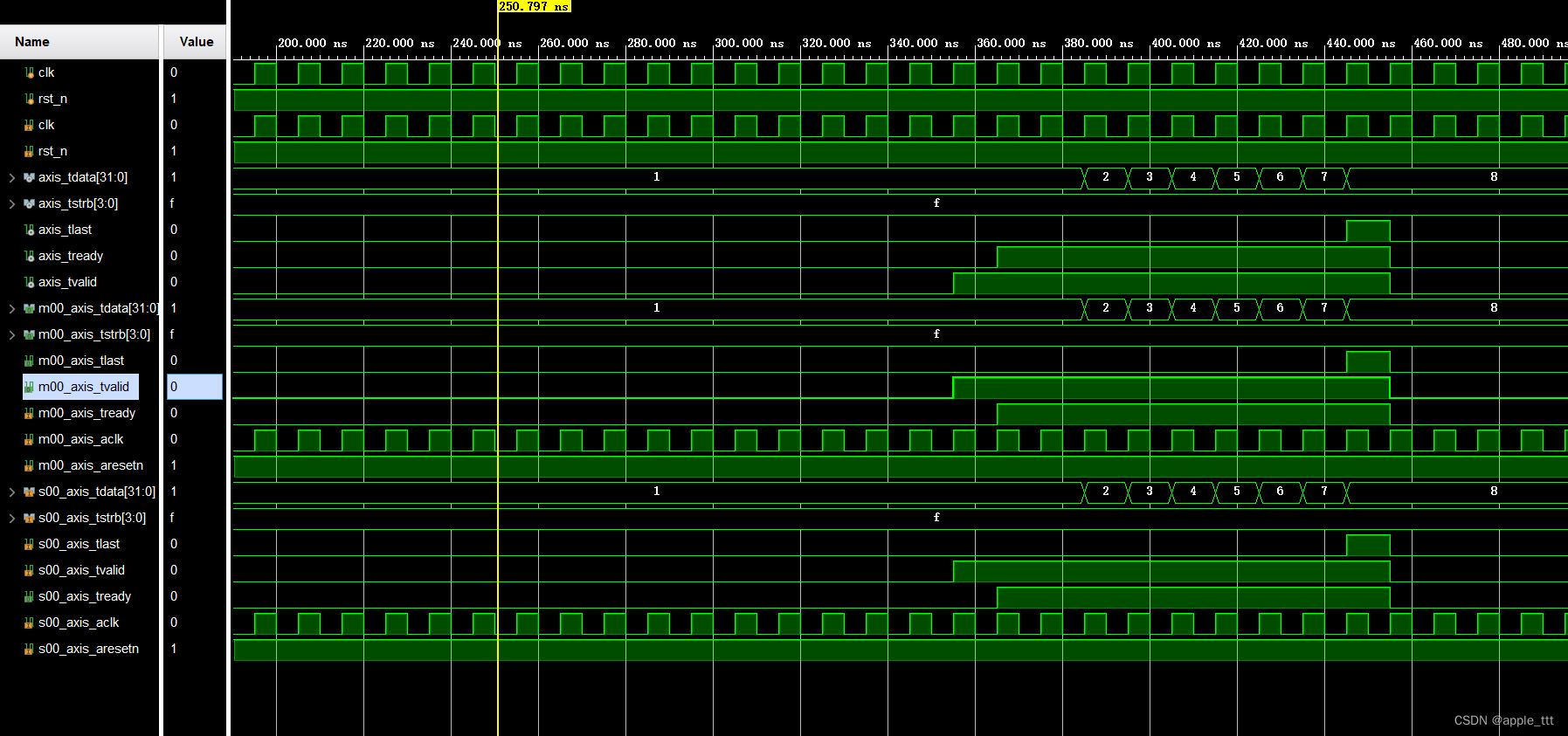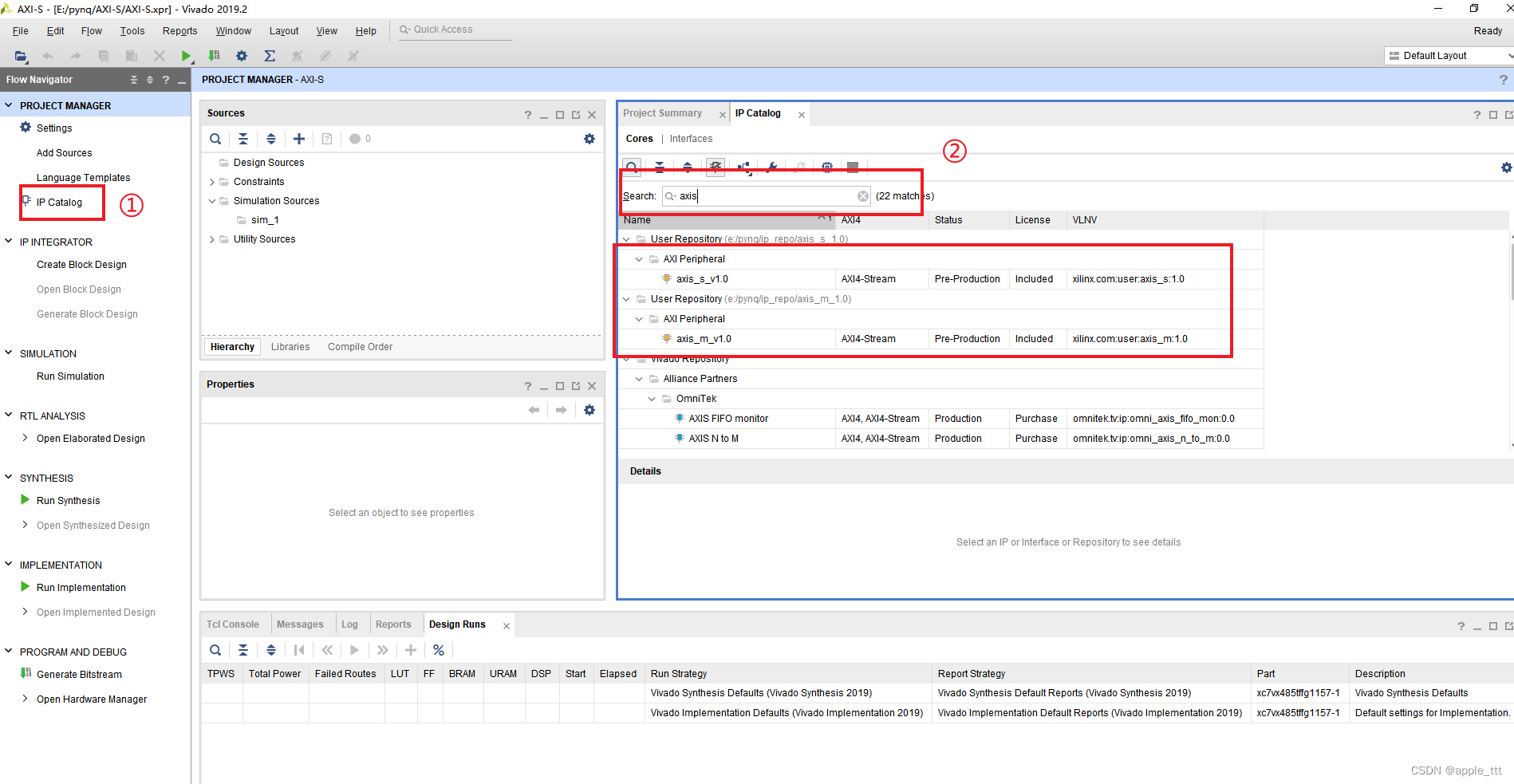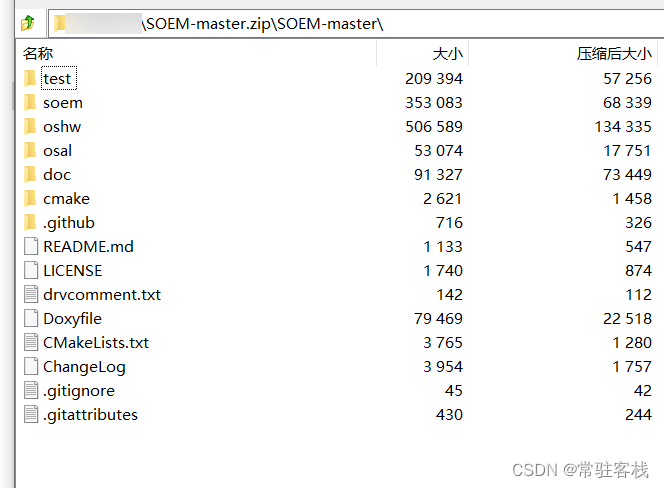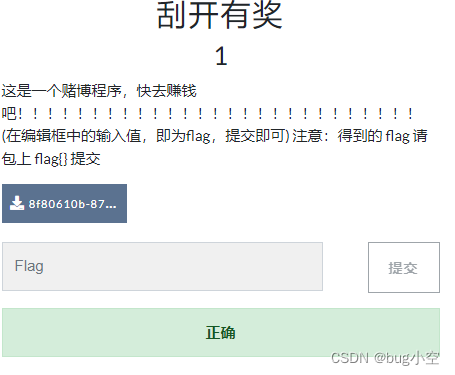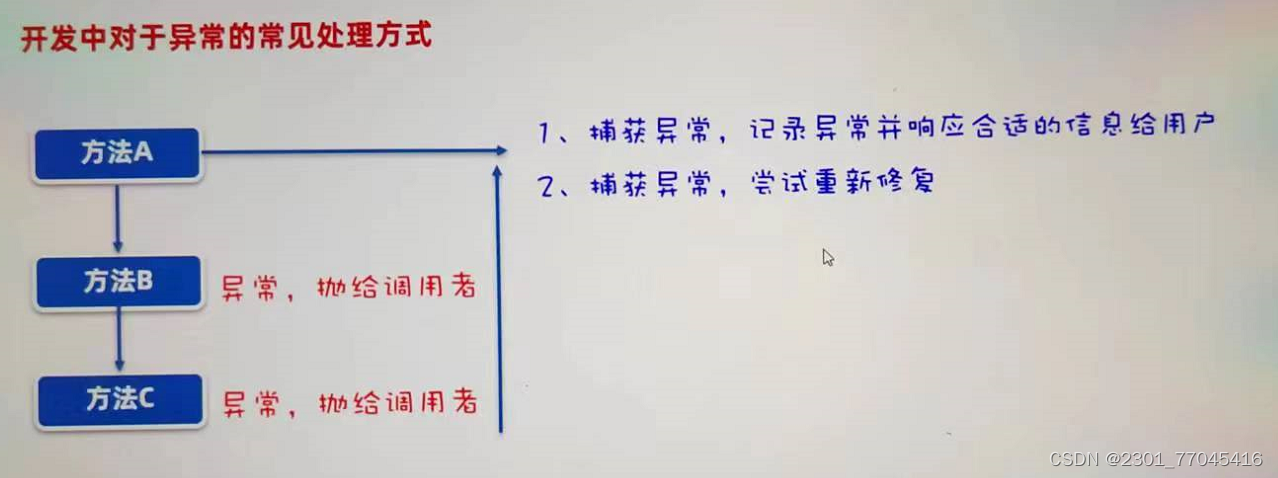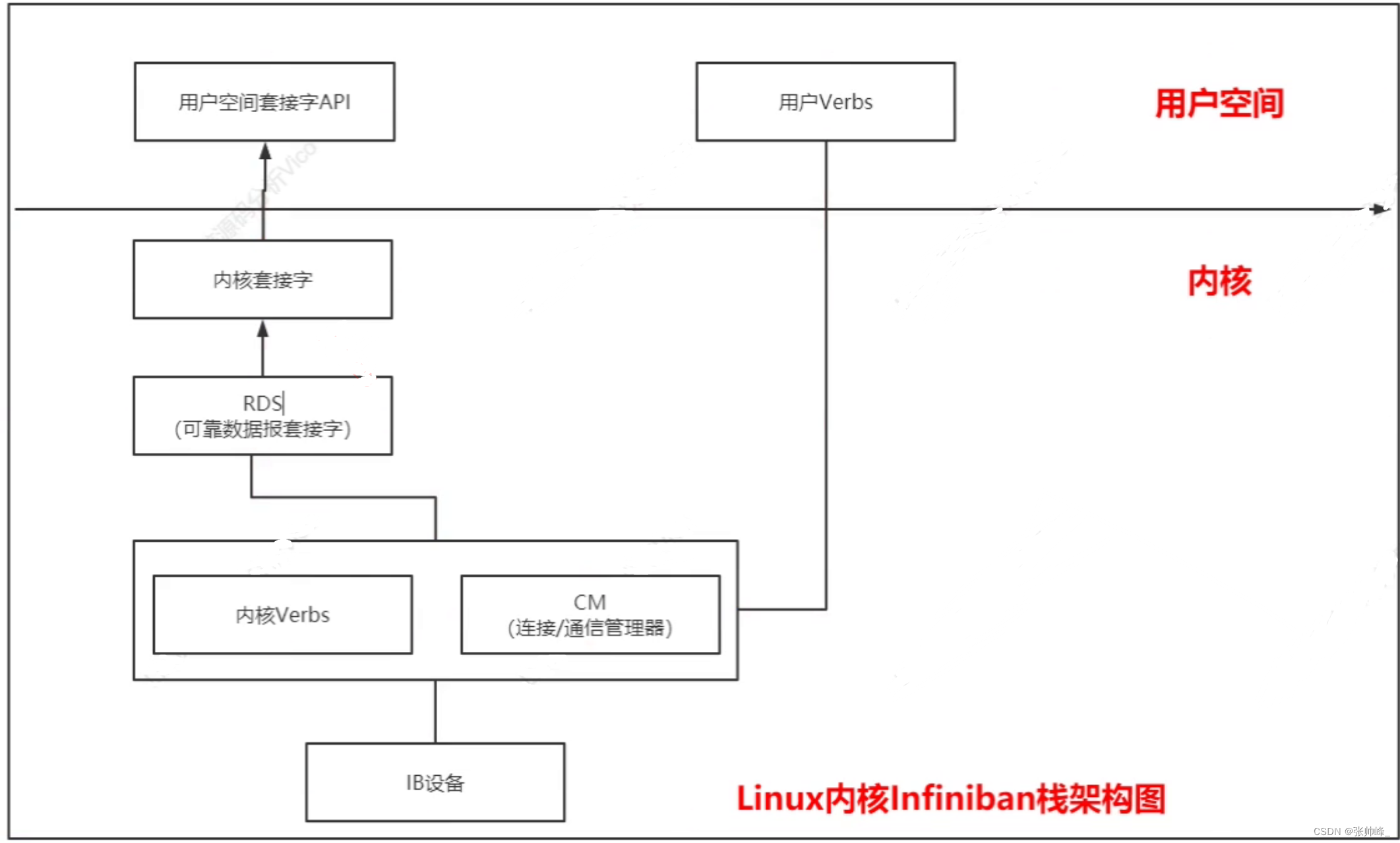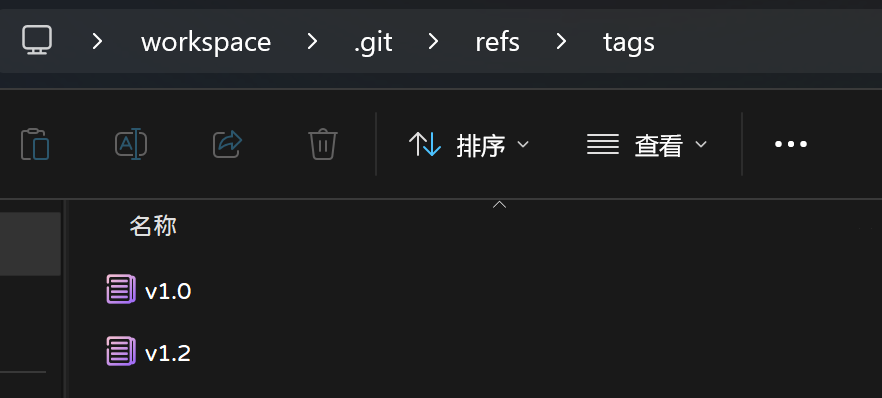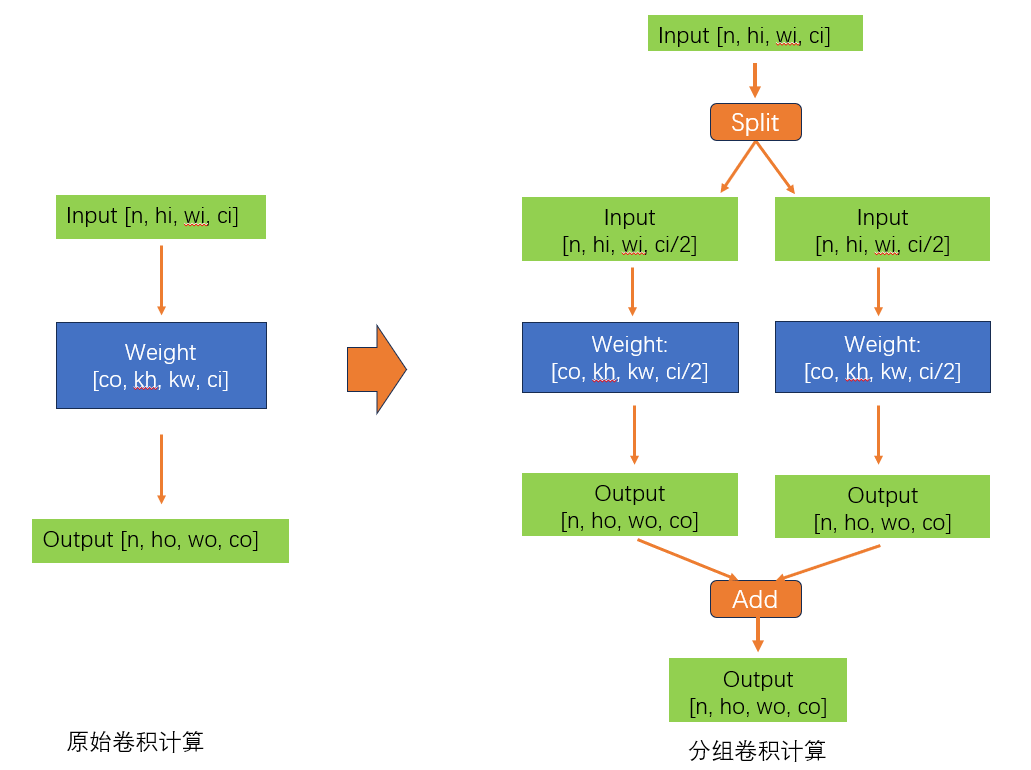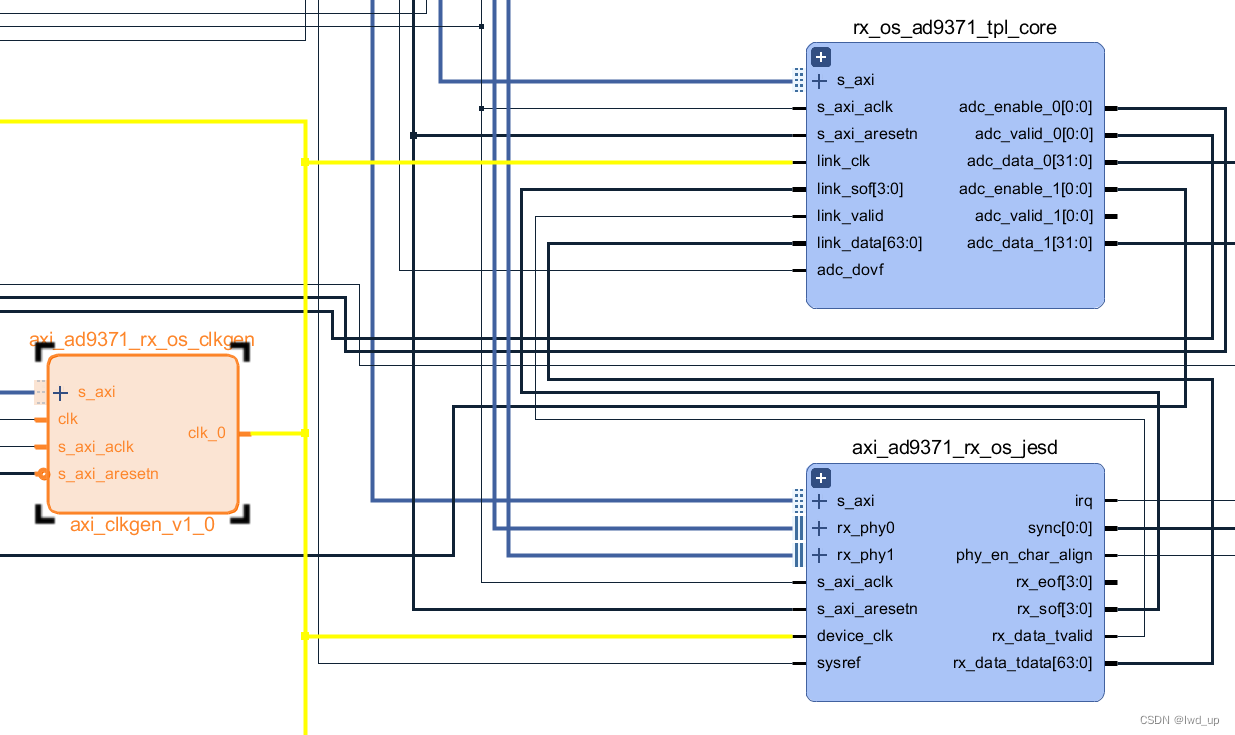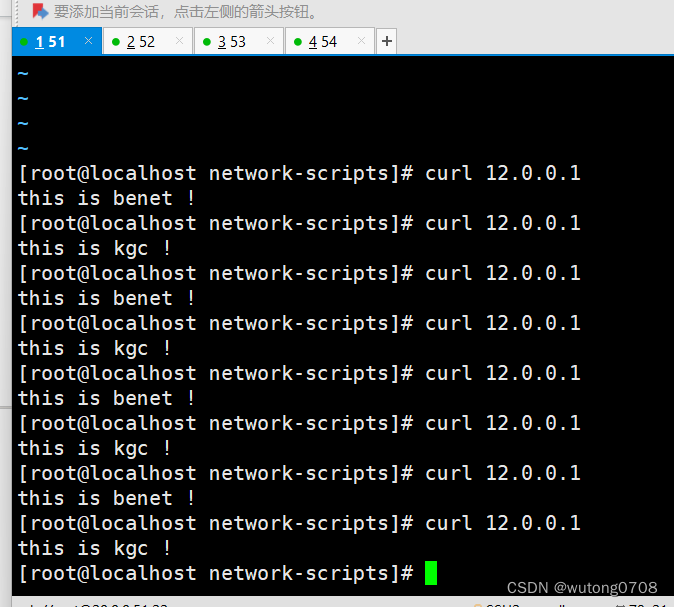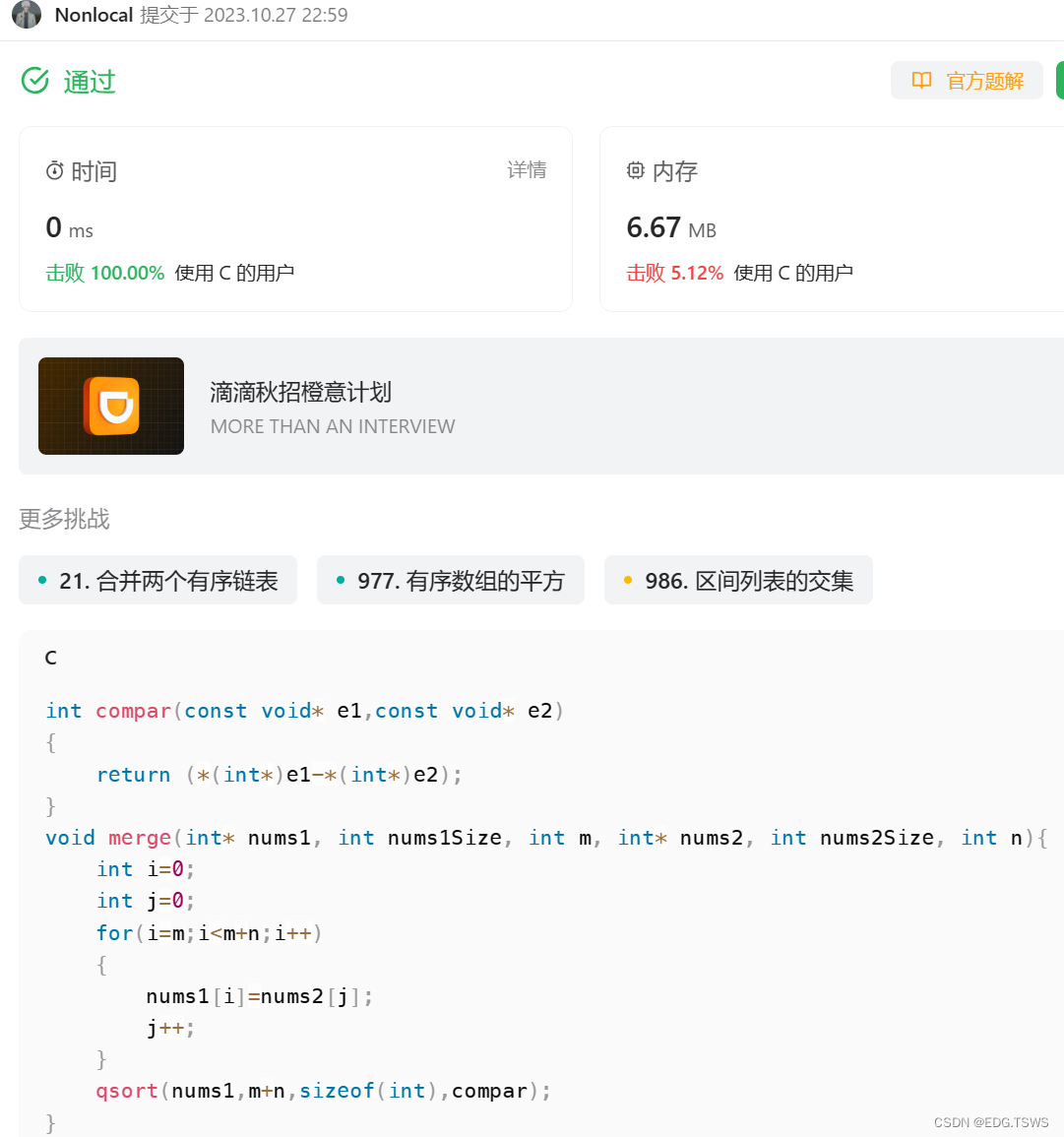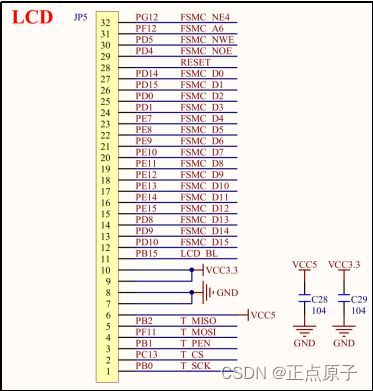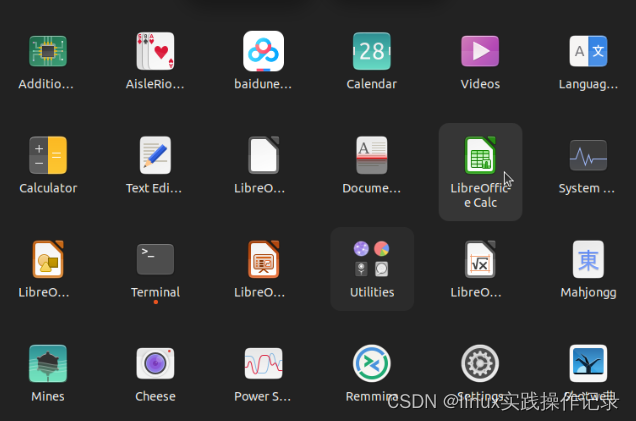一、前言
在之前的文章中,我们介绍了AXI-S协议的一些基础知识,这是我们进行本文学习的前置基础,因此建议在开始本文章的学习前,完整阅读以下两篇文章:
AXI-Stream协议详解(1)—— Introduction![]() https://blog.csdn.net/apple_53311083/article/details/134058532?spm=1001.2014.3001.5501AXI-Stream协议详解(2)—— Interface Signals
https://blog.csdn.net/apple_53311083/article/details/134058532?spm=1001.2014.3001.5501AXI-Stream协议详解(2)—— Interface Signals![]() https://blog.csdn.net/apple_53311083/article/details/134065597?spm=1001.2014.3001.5501
https://blog.csdn.net/apple_53311083/article/details/134065597?spm=1001.2014.3001.5501
二、带AXI-Stream接口的IP核
1、IP核创建
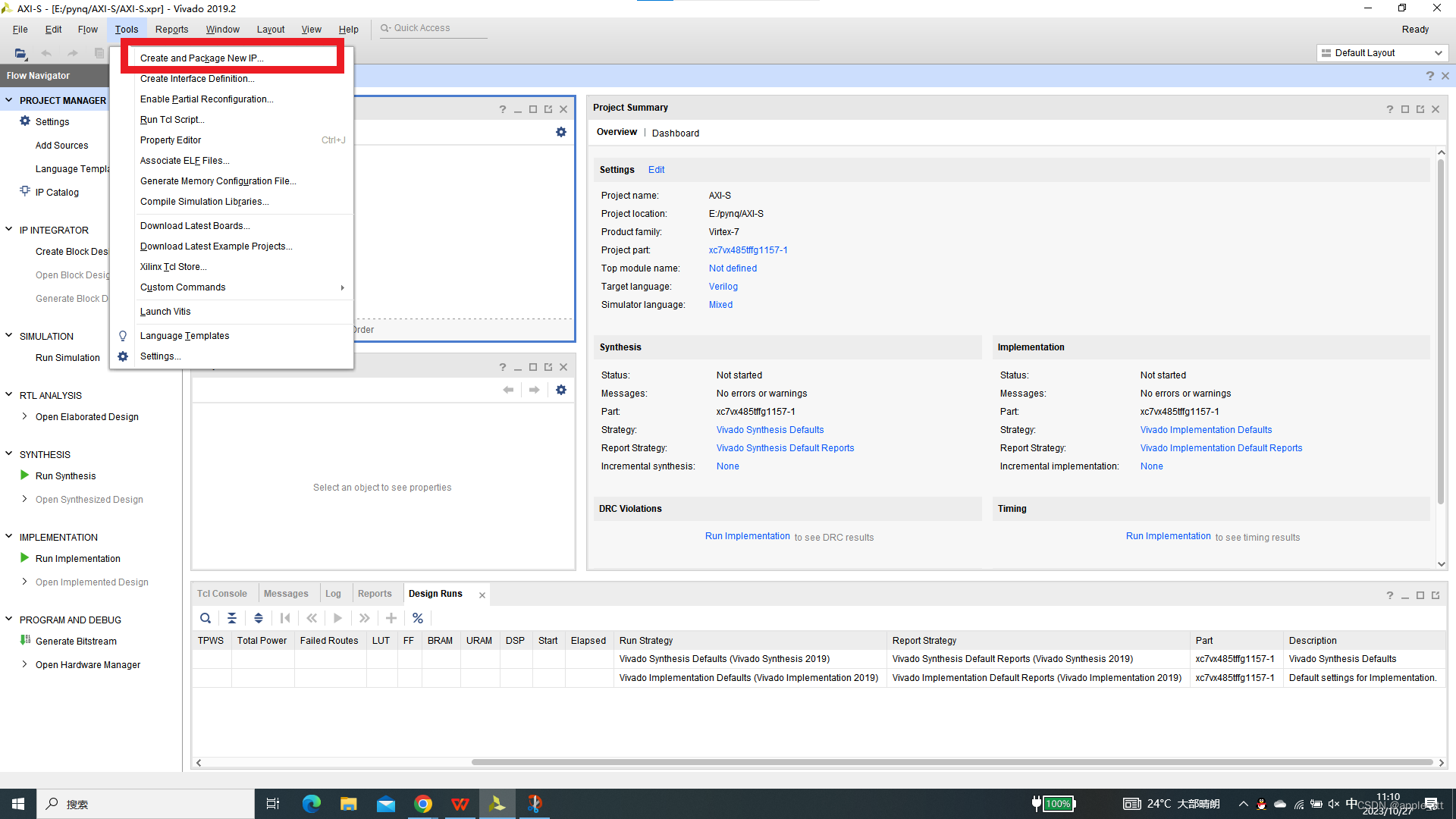
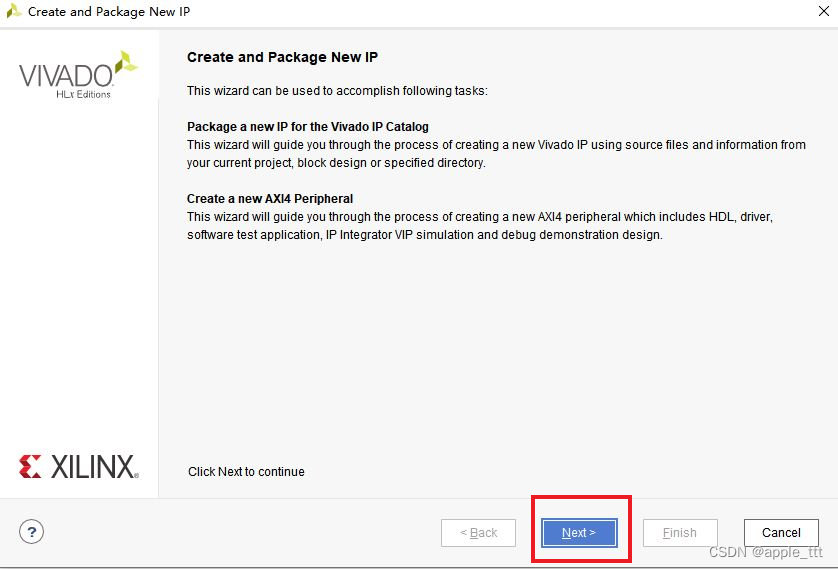
在这里我们选择最底下的一项,创建一个带有AXI接口的IP核

接下来我们设置IP核的一些细节信息,这里把名称改成了axis_m,代表这是AXI-Stream协议的主机。

选择stream协议,选择主机类型,相应地完成名称更改,这里的数据位宽我们暂时不做更改,保持默认的32bit就行。
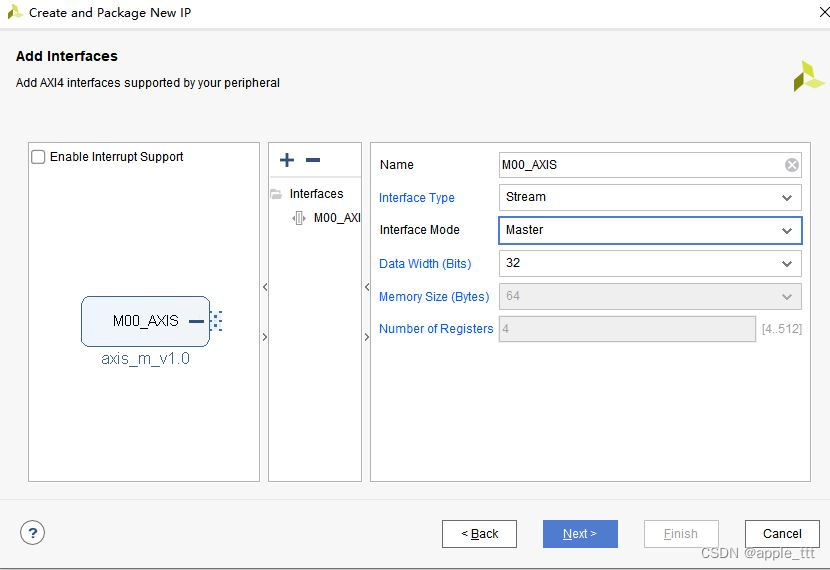
最后这里直接添加到IP库里就完成了。
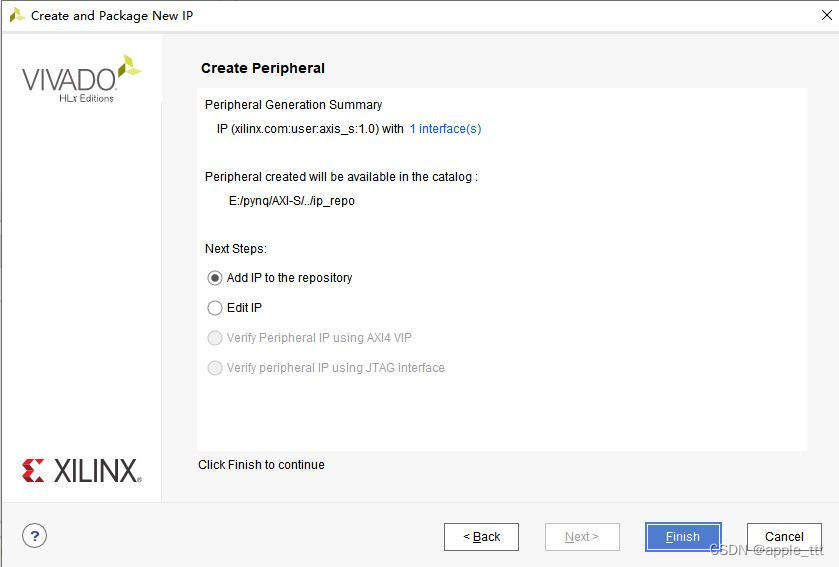
然后我们通过同样的方式可以完成axi_s(带有AXI-S接口的从机)的创建,这里就省略创建过程了。
2、IP核学习
在IP Catlog下搜索找到我们之前创建的2个带有AXI-Stream协议的IP核
右击选择Edit in packager
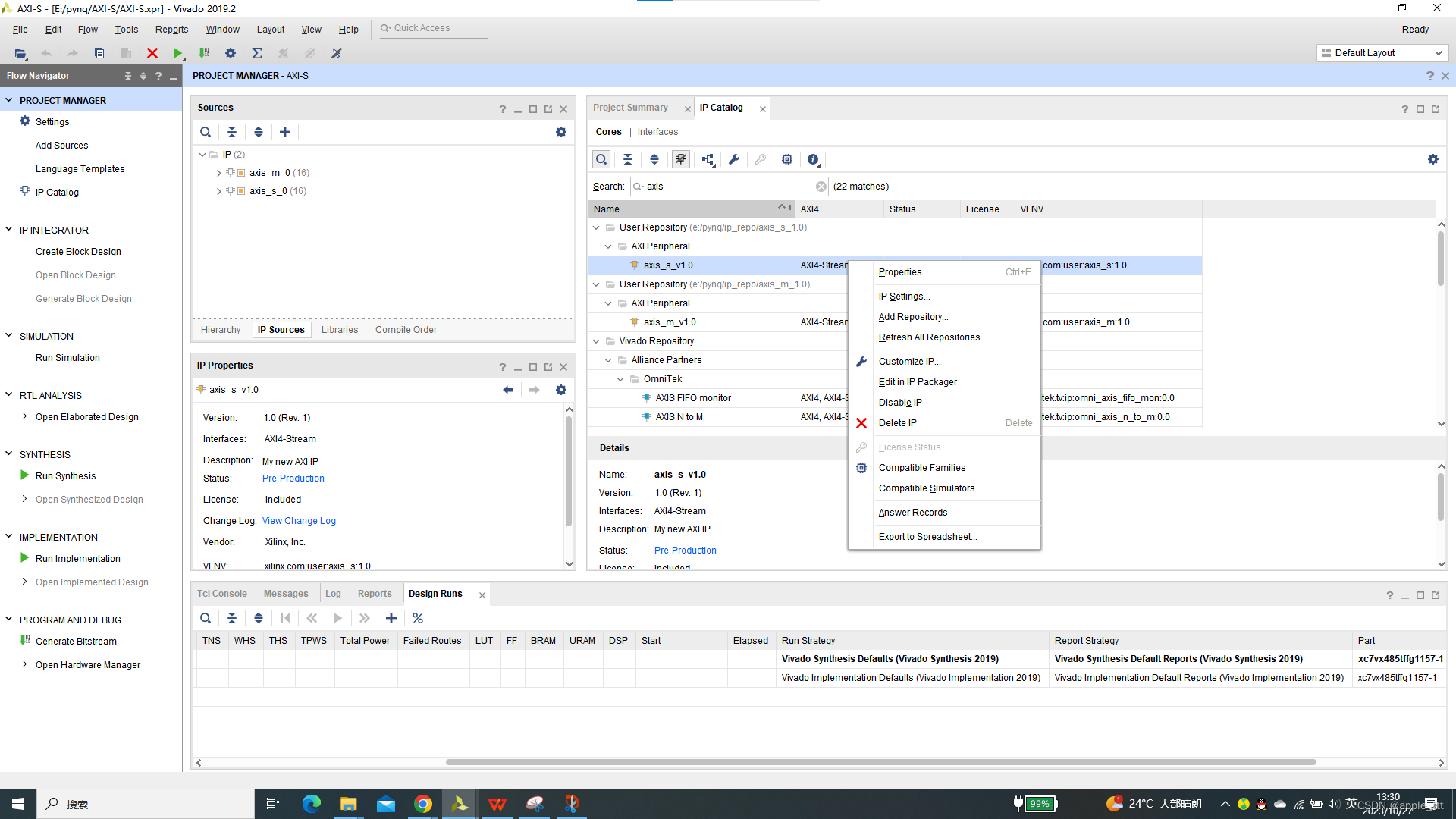
我们先以从机为例,显示如何找到AXI-S的设计部分,直接点击OK直到打开一个新的vivado界面
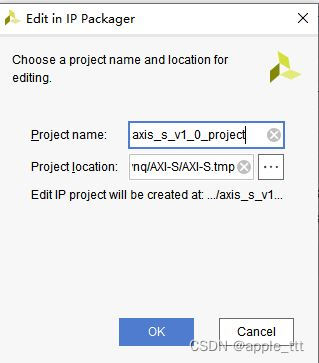

可以看到里面有两个模块
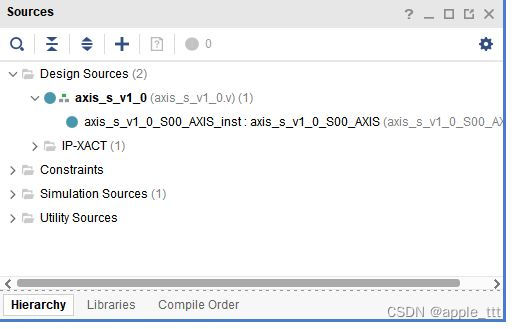
我们依次打开两个文件,同时可以把axis_m IP核中的文件同时打开,方便我们进行学习,打开过程同上,这里不做重复。
对于axis_s_v1_0和axis_m_v1_0这两个模块来说,只是完成了对底层模块的一个例化,所以没有什么可以过多赘述的。
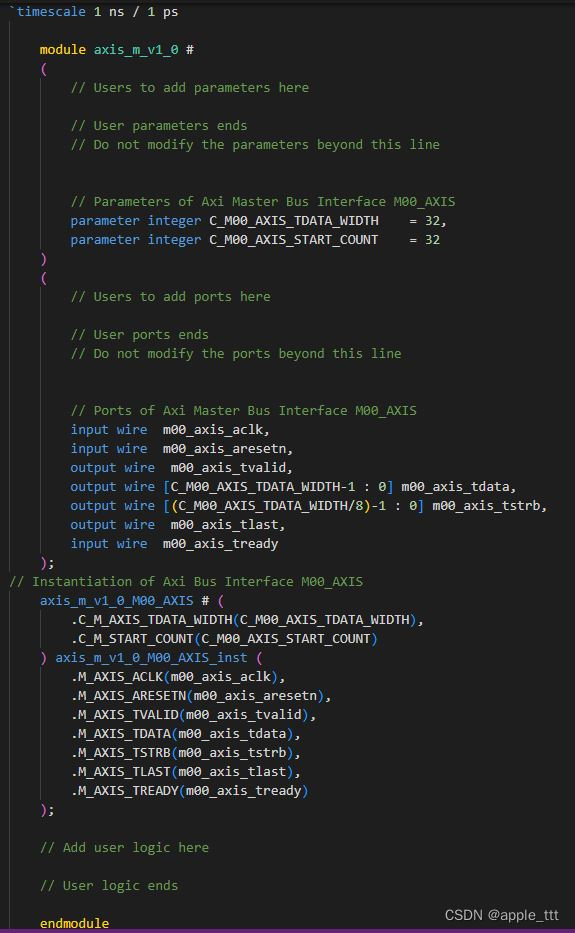

下面我们着重介绍axis_s_v1_0_S00_AXIS和axis_m_v1_0_M00_AXIS两个模块
三、AXI-Stream源代码学习
其实Xilinx官方已经给出了非常详细的英文注释,可以帮助我们快速了解整个AXI-S协议的实现方式,写的真的非常好。这里也只是在其基础上做一个简单的翻译和补充,首先给出笔者中文注释版本,再给出官方的注释版本,推荐阅读后者。
1、AXIS主机部分
1.1 中文注释
`timescale 1 ns / 1 ps
module axis_m_v1_0_M00_AXIS #
(
/*
用户可以在此自定义参数
*/
parameter integer C_M_AXIS_TDATA_WIDTH = 32, // 发送数据的位宽
// 初始化的最大计数时钟(等待系统稳定的时间)
parameter integer C_M_START_COUNT = 32
)
(
/*
用户可以在此自定义端口
*/
//全局信号
input wire M_AXIS_ACLK, // 时钟信号
input wire M_AXIS_ARESETN, // 复位信号(低电平有效)
output wire M_AXIS_TVALID, //有效信号,代表主机已经准备好了
output wire [C_M_AXIS_TDATA_WIDTH-1 : 0] M_AXIS_TDATA, //数据信号
output wire [(C_M_AXIS_TDATA_WIDTH/8)-1 : 0] M_AXIS_TSTRB, //数据修饰符,辨别字节类型
output wire M_AXIS_TLAST, //last信号,拉高代表是传输中的最后一个字节
input wire M_AXIS_TREADY //ready信号,代表从机准备好了
);
localparam NUMBER_OF_OUTPUT_WORDS = 8; //发送数据的个数
//函数:以2为低求对数,用于计算位宽
function integer clogb2 (input integer bit_depth);
begin
for(clogb2=0; bit_depth>0; clogb2=clogb2+1)
bit_depth = bit_depth >> 1;
end
endfunction
localparam integer WAIT_COUNT_BITS = clogb2(C_M_START_COUNT-1); //等待计时寄存器的位宽
localparam bit_num = clogb2(NUMBER_OF_OUTPUT_WORDS); //发送数据寄存器位宽
//状态机参数
parameter [1:0] IDLE = 2'b00, //初始状态
INIT_COUNTER = 2'b01, //初始化计数器,等待计数值达到最大计数时钟,进入下一个状态
SEND_STREAM = 2'b10; //数据发送状态
reg [1:0] mst_exec_state; //状态寄存器
reg [bit_num-1:0] read_pointer; //FIFO读指针
// AXIS内部信号
reg [WAIT_COUNT_BITS-1 : 0] count; //等待计数器(实现我们之前说的计时功能)
wire axis_tvalid; //valid
reg axis_tvalid_delay; //延时一个时钟周期的valid
wire axis_tlast; //last
reg axis_tlast_delay; //延迟一个时钟周期的last
reg [C_M_AXIS_TDATA_WIDTH-1 : 0] stream_data_out; //data
wire tx_en; //发送使能
reg tx_done; //发送完成
//赋值操作
assign M_AXIS_TVALID = axis_tvalid_delay;
assign M_AXIS_TDATA = stream_data_out;
assign M_AXIS_TLAST = axis_tlast_delay;
assign M_AXIS_TSTRB = {(C_M_AXIS_TDATA_WIDTH/8){1'b1}}; //全1
//控制状态机
always @(posedge M_AXIS_ACLK)
begin
if (!M_AXIS_ARESETN)
begin
mst_exec_state <= IDLE;
count <= 0;
end
else
case (mst_exec_state)
IDLE: //一个周期后直接进入下一个状态
mst_exec_state <= INIT_COUNTER;
INIT_COUNTER: //计数器达到最大计数值,进入次态
if ( count == C_M_START_COUNT - 1 )
begin
mst_exec_state <= SEND_STREAM;
end
else
begin
count <= count + 1;
mst_exec_state <= INIT_COUNTER;
end
SEND_STREAM: //发送状态,完成发送后回到初始态
if (tx_done)
begin
mst_exec_state <= IDLE;
end
else
begin
mst_exec_state <= SEND_STREAM;
end
endcase
end
//valid信号(表示主机有没有准备好),当处于发送状态,读指针小于发送数据个数时(也就是处于发送状态且还有数据要发)生效
assign axis_tvalid = ((mst_exec_state == SEND_STREAM) && (read_pointer < NUMBER_OF_OUTPUT_WORDS));
//last信号(表示发送的最后一个字节),当读指针等于发送数据个数-1时生效
assign axis_tlast = (read_pointer == NUMBER_OF_OUTPUT_WORDS-1);
//完成axis_tvalid_delay,axis_tlast_delay(延迟一个时钟的valid和last)的赋值
always @(posedge M_AXIS_ACLK)
begin
if (!M_AXIS_ARESETN)
begin
axis_tvalid_delay <= 1'b0;
axis_tlast_delay <= 1'b0;
end
else
begin
axis_tvalid_delay <= axis_tvalid;
axis_tlast_delay <= axis_tlast;
end
end
//读指针
always@(posedge M_AXIS_ACLK)
begin
if(!M_AXIS_ARESETN) //复位
begin
read_pointer <= 0;
tx_done <= 1'b0;
end
else
if (read_pointer <= NUMBER_OF_OUTPUT_WORDS-1) //读指针小于等于发送数据个数-1,如果tx_en(发送使能),读指针递增,发送完成信号为0
begin
if (tx_en)
begin
read_pointer <= read_pointer + 1;
tx_done <= 1'b0;
end
end
else if (read_pointer == NUMBER_OF_OUTPUT_WORDS)
begin
tx_done <= 1'b1; //如果读指针等于发送数据个数,完成信号为1
end
end
assign tx_en = M_AXIS_TREADY && axis_tvalid; //读使能信号(从机+主机准备好)
//生成数据输出
always @( posedge M_AXIS_ACLK )
begin
if(!M_AXIS_ARESETN)
begin
stream_data_out <= 1;
end
else if (tx_en)
begin
stream_data_out <= read_pointer + 32'b1; //定义数据为指针+1
end
end
/*
实现用户逻辑
*/
endmodule
1.2 源码展示
`timescale 1 ns / 1 ps
module axis_m_v1_0_M00_AXIS #
(
// Users to add parameters here
// User parameters ends
// Do not modify the parameters beyond this line
// Width of S_AXIS address bus. The slave accepts the read and write addresses of width C_M_AXIS_TDATA_WIDTH.
parameter integer C_M_AXIS_TDATA_WIDTH = 32,
// Start count is the number of clock cycles the master will wait before initiating/issuing any transaction.
parameter integer C_M_START_COUNT = 32
)
(
// Users to add ports here
// User ports ends
// Do not modify the ports beyond this line
// Global ports
input wire M_AXIS_ACLK,
//
input wire M_AXIS_ARESETN,
// Master Stream Ports. TVALID indicates that the master is driving a valid transfer, A transfer takes place when both TVALID and TREADY are asserted.
output wire M_AXIS_TVALID,
// TDATA is the primary payload that is used to provide the data that is passing across the interface from the master.
output wire [C_M_AXIS_TDATA_WIDTH-1 : 0] M_AXIS_TDATA,
// TSTRB is the byte qualifier that indicates whether the content of the associated byte of TDATA is processed as a data byte or a position byte.
output wire [(C_M_AXIS_TDATA_WIDTH/8)-1 : 0] M_AXIS_TSTRB,
// TLAST indicates the boundary of a packet.
output wire M_AXIS_TLAST,
// TREADY indicates that the slave can accept a transfer in the current cycle.
input wire M_AXIS_TREADY
);
// Total number of output data
localparam NUMBER_OF_OUTPUT_WORDS = 8;
// function called clogb2 that returns an integer which has the
// value of the ceiling of the log base 2.
function integer clogb2 (input integer bit_depth);
begin
for(clogb2=0; bit_depth>0; clogb2=clogb2+1)
bit_depth = bit_depth >> 1;
end
endfunction
// WAIT_COUNT_BITS is the width of the wait counter.
localparam integer WAIT_COUNT_BITS = clogb2(C_M_START_COUNT-1);
// bit_num gives the minimum number of bits needed to address 'depth' size of FIFO.
localparam bit_num = clogb2(NUMBER_OF_OUTPUT_WORDS);
// Define the states of state machine
// The control state machine oversees the writing of input streaming data to the FIFO,
// and outputs the streaming data from the FIFO
parameter [1:0] IDLE = 2'b00, // This is the initial/idle state
INIT_COUNTER = 2'b01, // This state initializes the counter, once
// the counter reaches C_M_START_COUNT count,
// the state machine changes state to SEND_STREAM
SEND_STREAM = 2'b10; // In this state the
// stream data is output through M_AXIS_TDATA
// State variable
reg [1:0] mst_exec_state;
// Example design FIFO read pointer
reg [bit_num-1:0] read_pointer;
// AXI Stream internal signals
//wait counter. The master waits for the user defined number of clock cycles before initiating a transfer.
reg [WAIT_COUNT_BITS-1 : 0] count;
//streaming data valid
wire axis_tvalid;
//streaming data valid delayed by one clock cycle
reg axis_tvalid_delay;
//Last of the streaming data
wire axis_tlast;
//Last of the streaming data delayed by one clock cycle
reg axis_tlast_delay;
//FIFO implementation signals
reg [C_M_AXIS_TDATA_WIDTH-1 : 0] stream_data_out;
wire tx_en;
//The master has issued all the streaming data stored in FIFO
reg tx_done;
// I/O Connections assignments
assign M_AXIS_TVALID = axis_tvalid_delay;
assign M_AXIS_TDATA = stream_data_out;
assign M_AXIS_TLAST = axis_tlast_delay;
assign M_AXIS_TSTRB = {(C_M_AXIS_TDATA_WIDTH/8){1'b1}};
// Control state machine implementation
always @(posedge M_AXIS_ACLK)
begin
if (!M_AXIS_ARESETN)
// Synchronous reset (active low)
begin
mst_exec_state <= IDLE;
count <= 0;
end
else
case (mst_exec_state)
IDLE:
// The slave starts accepting tdata when
// there tvalid is asserted to mark the
// presence of valid streaming data
//if ( count == 0 )
// begin
mst_exec_state <= INIT_COUNTER;
// end
//else
// begin
// mst_exec_state <= IDLE;
// end
INIT_COUNTER:
// The slave starts accepting tdata when
// there tvalid is asserted to mark the
// presence of valid streaming data
if ( count == C_M_START_COUNT - 1 )
begin
mst_exec_state <= SEND_STREAM;
end
else
begin
count <= count + 1;
mst_exec_state <= INIT_COUNTER;
end
SEND_STREAM:
// The example design streaming master functionality starts
// when the master drives output tdata from the FIFO and the slave
// has finished storing the S_AXIS_TDATA
if (tx_done)
begin
mst_exec_state <= IDLE;
end
else
begin
mst_exec_state <= SEND_STREAM;
end
endcase
end
//tvalid generation
//axis_tvalid is asserted when the control state machine's state is SEND_STREAM and
//number of output streaming data is less than the NUMBER_OF_OUTPUT_WORDS.
assign axis_tvalid = ((mst_exec_state == SEND_STREAM) && (read_pointer < NUMBER_OF_OUTPUT_WORDS));
// AXI tlast generation
// axis_tlast is asserted number of output streaming data is NUMBER_OF_OUTPUT_WORDS-1
// (0 to NUMBER_OF_OUTPUT_WORDS-1)
assign axis_tlast = (read_pointer == NUMBER_OF_OUTPUT_WORDS-1);
// Delay the axis_tvalid and axis_tlast signal by one clock cycle
// to match the latency of M_AXIS_TDATA
always @(posedge M_AXIS_ACLK)
begin
if (!M_AXIS_ARESETN)
begin
axis_tvalid_delay <= 1'b0;
axis_tlast_delay <= 1'b0;
end
else
begin
axis_tvalid_delay <= axis_tvalid;
axis_tlast_delay <= axis_tlast;
end
end
//read_pointer pointer
always@(posedge M_AXIS_ACLK)
begin
if(!M_AXIS_ARESETN)
begin
read_pointer <= 0;
tx_done <= 1'b0;
end
else
if (read_pointer <= NUMBER_OF_OUTPUT_WORDS-1)
begin
if (tx_en)
// read pointer is incremented after every read from the FIFO
// when FIFO read signal is enabled.
begin
read_pointer <= read_pointer + 1;
tx_done <= 1'b0;
end
end
else if (read_pointer == NUMBER_OF_OUTPUT_WORDS)
begin
// tx_done is asserted when NUMBER_OF_OUTPUT_WORDS numbers of streaming data
// has been out.
tx_done <= 1'b1;
end
end
//FIFO read enable generation
assign tx_en = M_AXIS_TREADY && axis_tvalid;
// Streaming output data is read from FIFO
always @( posedge M_AXIS_ACLK )
begin
if(!M_AXIS_ARESETN)
begin
stream_data_out <= 1;
end
else if (tx_en)// && M_AXIS_TSTRB[byte_index]
begin
stream_data_out <= read_pointer + 32'b1;
end
end
// Add user logic here
// User logic ends
endmodule
2、AXIS从机部分
1.1 中文注释
`timescale 1 ns / 1 ps
module axis_s_v1_0_S00_AXIS #
(
/*
用户可以自定义参数
*/
//AXIS数据位宽
parameter integer C_S_AXIS_TDATA_WIDTH = 32
)
(
/*
用户可以在此自定义端口
*/
input wire S_AXIS_ACLK, //时钟信号
input wire S_AXIS_ARESETN, //复位信号
output wire S_AXIS_TREADY, //ready信号,代表从机准备好了
input wire [C_S_AXIS_TDATA_WIDTH-1 : 0] S_AXIS_TDATA, //数据信号
input wire [(C_S_AXIS_TDATA_WIDTH/8)-1 : 0] S_AXIS_TSTRB, //数据修饰符,辨别字节类型
input wire S_AXIS_TLAST, //last信号,拉高代表是传输中的最后一个字节
input wire S_AXIS_TVALID //ready信号,代表从机准备好了
);
//函数:以2为低求对数,用于计算位宽
function integer clogb2 (input integer bit_depth);
begin
for(clogb2=0; bit_depth>0; clogb2=clogb2+1)
bit_depth = bit_depth >> 1;
end
endfunction
localparam NUMBER_OF_INPUT_WORDS = 8; //输入数据个数
localparam bit_num = clogb2(NUMBER_OF_INPUT_WORDS-1); //输入数据的位宽
//状态机定义
parameter [1:0] IDLE = 1'b0, //初始状态
WRITE_FIFO = 1'b1; //读状态
wire axis_tready; //ready信号
reg mst_exec_state; //状态寄存器
genvar byte_index; //字节索引
wire fifo_wren; //FIFO写使能
reg fifo_full_flag; //FIFO满标志
reg [bit_num-1:0] write_pointer; //FIFO写指针
reg writes_done; //写满标志
assign S_AXIS_TREADY = axis_tready;
//状态机
always @(posedge S_AXIS_ACLK)
begin
if (!S_AXIS_ARESETN)
begin
mst_exec_state <= IDLE;
end
else
case (mst_exec_state)
IDLE:
if (S_AXIS_TVALID)
begin
mst_exec_state <= WRITE_FIFO;
end
else
begin
mst_exec_state <= IDLE;
end
WRITE_FIFO:
if (writes_done)
begin
mst_exec_state <= IDLE;
end
else
begin
mst_exec_state <= WRITE_FIFO;
end
endcase
end
//ready信号赋值,写状态+读指针写于等于接收数据总个数
assign axis_tready = ((mst_exec_state == WRITE_FIFO) && (write_pointer <= NUMBER_OF_INPUT_WORDS-1));
//写指针,写完成信号
always@(posedge S_AXIS_ACLK)
begin
if(!S_AXIS_ARESETN)
begin
write_pointer <= 0;
writes_done <= 1'b0;
end
else
if (write_pointer <= NUMBER_OF_INPUT_WORDS-1)
begin
if (fifo_wren)
begin
write_pointer <= write_pointer + 1;
writes_done <= 1'b0;
end
if ((write_pointer == NUMBER_OF_INPUT_WORDS-1)|| S_AXIS_TLAST)
begin
writes_done <= 1'b1;
end
end
end
//FIFO写使能信号
assign fifo_wren = S_AXIS_TVALID && axis_tready;
//例化4个宽为8,深度为8的二维数组stream_data_fifo,用来充当FIFO,每个FIFO依次写入数据的0-7;8-15;16-23;24-31位
generate
for(byte_index=0; byte_index<= (C_S_AXIS_TDATA_WIDTH/8-1); byte_index=byte_index+1)
begin:FIFO_GEN
reg [(C_S_AXIS_TDATA_WIDTH/4)-1:0] stream_data_fifo [0 : NUMBER_OF_INPUT_WORDS-1];
//写入FIFO数据
always @( posedge S_AXIS_ACLK )
begin
if (fifo_wren)// && S_AXIS_TSTRB[byte_index])
begin
stream_data_fifo[write_pointer] <= S_AXIS_TDATA[(byte_index*8+7) -: 8];
end
end
end
endgenerate
/*
实现用户逻辑
*/
endmodule
1.2 源码展示
`timescale 1 ns / 1 ps
module axis_s_v1_0_S00_AXIS #
(
// Users to add parameters here
// User parameters ends
// Do not modify the parameters beyond this line
// AXI4Stream sink: Data Width
parameter integer C_S_AXIS_TDATA_WIDTH = 32
)
(
// Users to add ports here
// User ports ends
// Do not modify the ports beyond this line
// AXI4Stream sink: Clock
input wire S_AXIS_ACLK,
// AXI4Stream sink: Reset
input wire S_AXIS_ARESETN,
// Ready to accept data in
output wire S_AXIS_TREADY,
// Data in
input wire [C_S_AXIS_TDATA_WIDTH-1 : 0] S_AXIS_TDATA,
// Byte qualifier
input wire [(C_S_AXIS_TDATA_WIDTH/8)-1 : 0] S_AXIS_TSTRB,
// Indicates boundary of last packet
input wire S_AXIS_TLAST,
// Data is in valid
input wire S_AXIS_TVALID
);
// function called clogb2 that returns an integer which has the
// value of the ceiling of the log base 2.
function integer clogb2 (input integer bit_depth);
begin
for(clogb2=0; bit_depth>0; clogb2=clogb2+1)
bit_depth = bit_depth >> 1;
end
endfunction
// Total number of input data.
localparam NUMBER_OF_INPUT_WORDS = 8;
// bit_num gives the minimum number of bits needed to address 'NUMBER_OF_INPUT_WORDS' size of FIFO.
localparam bit_num = clogb2(NUMBER_OF_INPUT_WORDS-1);
// Define the states of state machine
// The control state machine oversees the writing of input streaming data to the FIFO,
// and outputs the streaming data from the FIFO
parameter [1:0] IDLE = 1'b0, // This is the initial/idle state
WRITE_FIFO = 1'b1; // In this state FIFO is written with the
// input stream data S_AXIS_TDATA
wire axis_tready;
// State variable
reg mst_exec_state;
// FIFO implementation signals
genvar byte_index;
// FIFO write enable
wire fifo_wren;
// FIFO full flag
reg fifo_full_flag;
// FIFO write pointer
reg [bit_num-1:0] write_pointer;
// sink has accepted all the streaming data and stored in FIFO
reg writes_done;
// I/O Connections assignments
assign S_AXIS_TREADY = axis_tready;
// Control state machine implementation
always @(posedge S_AXIS_ACLK)
begin
if (!S_AXIS_ARESETN)
// Synchronous reset (active low)
begin
mst_exec_state <= IDLE;
end
else
case (mst_exec_state)
IDLE:
// The sink starts accepting tdata when
// there tvalid is asserted to mark the
// presence of valid streaming data
if (S_AXIS_TVALID)
begin
mst_exec_state <= WRITE_FIFO;
end
else
begin
mst_exec_state <= IDLE;
end
WRITE_FIFO:
// When the sink has accepted all the streaming input data,
// the interface swiches functionality to a streaming master
if (writes_done)
begin
mst_exec_state <= IDLE;
end
else
begin
// The sink accepts and stores tdata
// into FIFO
mst_exec_state <= WRITE_FIFO;
end
endcase
end
// AXI Streaming Sink
//
// The example design sink is always ready to accept the S_AXIS_TDATA until
// the FIFO is not filled with NUMBER_OF_INPUT_WORDS number of input words.
assign axis_tready = ((mst_exec_state == WRITE_FIFO) && (write_pointer <= NUMBER_OF_INPUT_WORDS-1));
always@(posedge S_AXIS_ACLK)
begin
if(!S_AXIS_ARESETN)
begin
write_pointer <= 0;
writes_done <= 1'b0;
end
else
if (write_pointer <= NUMBER_OF_INPUT_WORDS-1)
begin
if (fifo_wren)
begin
// write pointer is incremented after every write to the FIFO
// when FIFO write signal is enabled.
write_pointer <= write_pointer + 1;
writes_done <= 1'b0;
end
if ((write_pointer == NUMBER_OF_INPUT_WORDS-1)|| S_AXIS_TLAST)
begin
// reads_done is asserted when NUMBER_OF_INPUT_WORDS numbers of streaming data
// has been written to the FIFO which is also marked by S_AXIS_TLAST(kept for optional usage).
writes_done <= 1'b1;
end
end
end
// FIFO write enable generation
assign fifo_wren = S_AXIS_TVALID && axis_tready;
// FIFO Implementation
generate
for(byte_index=0; byte_index<= (C_S_AXIS_TDATA_WIDTH/8-1); byte_index=byte_index+1)
begin:FIFO_GEN
reg [(C_S_AXIS_TDATA_WIDTH/4)-1:0] stream_data_fifo [0 : NUMBER_OF_INPUT_WORDS-1];
// Streaming input data is stored in FIFO
always @( posedge S_AXIS_ACLK )
begin
if (fifo_wren)// && S_AXIS_TSTRB[byte_index])
begin
stream_data_fifo[write_pointer] <= S_AXIS_TDATA[(byte_index*8+7) -: 8];
end
end
end
endgenerate
// Add user logic here
// User logic ends
endmodule
四、仿真测试
1、top
module top(
input clk,
input rst_n
);
wire [31:0] axis_tdata;
wire [3:0] axis_tstrb;
wire axis_tlast;
wire axis_tready;
wire axis_tvalid;
axis_m_0 axis_m_u0
(
.m00_axis_tdata (axis_tdata),
.m00_axis_tstrb (axis_tstrb),
.m00_axis_tlast (axis_tlast),
.m00_axis_tvalid (axis_tvalid),
.m00_axis_tready (axis_tready),
.m00_axis_aclk (clk),
.m00_axis_aresetn (rst_n)
);
axis_s_0 axis_s_u0
(
.s00_axis_tdata (axis_tdata),
.s00_axis_tstrb (axis_tstrb),
.s00_axis_tlast (axis_tlast),
.s00_axis_tvalid (axis_tvalid),
.s00_axis_tready (axis_tready),
.s00_axis_aclk (clk),
.s00_axis_aresetn (rst_n)
);
endmodule
2、tb
`timescale 1ns / 1ps
module tb_top();
reg clk,rst_n;
initial begin
clk = 0;
rst_n = 1;
#10
rst_n = 0;
#10
rst_n = 1;
end
always #5 clk <= ~clk;
top top_u1(.clk(clk),
.rst_n(rst_n));
endmodule
3、结果
